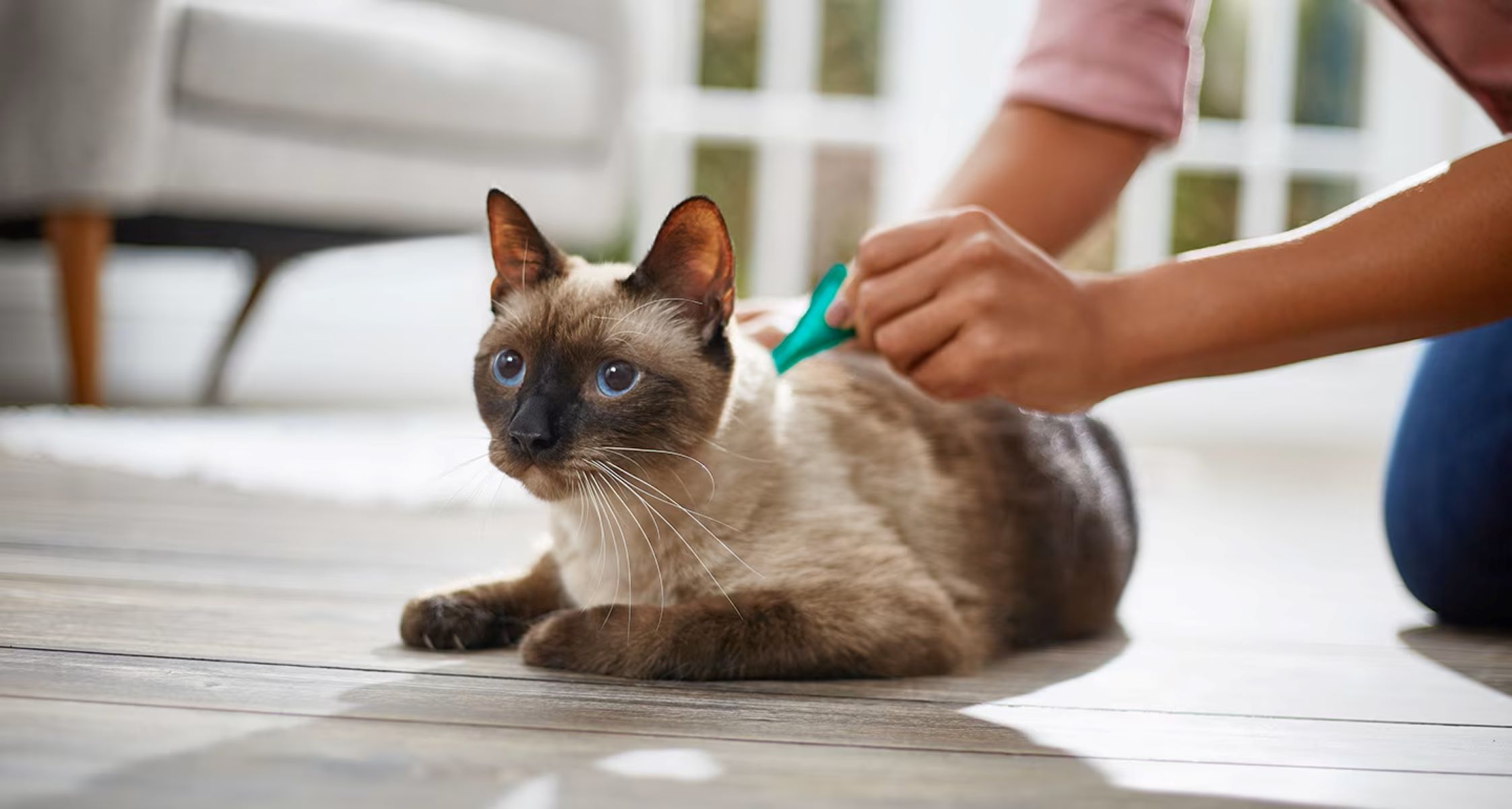Home>Pets & Animals>The Ultimate Guide To Applying Flea And Tick Medicine On Your Cat


Pets & Animals
The Ultimate Guide To Applying Flea And Tick Medicine On Your Cat
Published: January 21, 2024
Learn the best techniques for applying flea and tick medicine on your cat with our comprehensive guide. Keep your feline friend protected and healthy. Ideal for pet owners seeking expert advice.
(Many of the links in this article redirect to a specific reviewed product. Your purchase of these products through affiliate links helps to generate commission for Regretless.com, at no extra cost. Learn more)
Table of Contents
Introduction
Fleas and ticks are not just a nuisance for your feline friend; they can pose serious health risks. These pesky parasites can cause discomfort, irritation, and even transmit diseases to your beloved cat. As a responsible pet owner, it's crucial to protect your cat from these potential threats. One of the most effective ways to safeguard your cat's well-being is by applying flea and tick medicine.
In this comprehensive guide, we will delve into the world of flea and tick prevention for cats. You'll gain valuable insights into the different types of flea and tick medicine available, the considerations for choosing the right one for your cat, and the essential steps for applying these medications. Additionally, we'll explore the importance of monitoring and maintaining your cat's health after administering the medicine.
By the end of this guide, you'll be equipped with the knowledge and confidence to effectively protect your feline companion from fleas and ticks. Let's embark on this journey to ensure a happier, healthier life for your cherished cat.
Understanding Fleas and Ticks
Fleas and ticks are more than just pesky insects; they are formidable adversaries that can wreak havoc on your cat's health. Understanding these parasites is crucial for effective prevention and treatment.
Fleas
Fleas are tiny, wingless insects that survive by feeding on the blood of their hosts. These agile parasites can jump significant distances, allowing them to easily move between animals and infest new environments. Once on your cat, fleas can cause intense itching, skin irritation, and allergic reactions. In severe cases, flea infestations can lead to anemia, especially in young or small cats.
Ticks
Ticks are arachnids that attach themselves to animals, including cats, to feed on their blood. These parasites can transmit a variety of diseases, such as Lyme disease and ehrlichiosis, through their bites. Ticks are commonly found in grassy, wooded, or outdoor areas, making outdoor cats particularly susceptible to infestations.
Risks to Cats
Both fleas and ticks pose significant health risks to cats. Beyond the discomfort and irritation they cause, these parasites can transmit diseases and lead to secondary infections. Anemia, skin infections, and allergic dermatitis are just a few of the potential consequences of flea and tick infestations in cats.
Understanding the behavior and potential impact of fleas and ticks is essential for proactive prevention. By gaining insight into their habits and the risks they pose, you can take the necessary steps to protect your cat from these troublesome parasites.
In the next sections, we will explore the various types of flea and tick medicine available and the considerations for choosing the most suitable option for your cat. This knowledge will empower you to make informed decisions and safeguard your cat's well-being effectively.
Types of Flea and Tick Medicine
When it comes to protecting your cat from fleas and ticks, a variety of medications are available to address these pesky parasites. Understanding the different types of flea and tick medicine is essential for selecting the most suitable option for your feline companion. Here are the primary categories of flea and tick treatments for cats:
Topical Treatments
Topical flea and tick medications are applied directly to your cat's skin, typically between the shoulder blades or at the base of the skull. These treatments often come in the form of spot-on solutions or sprays. Once applied, the medication spreads across the skin and provides long-lasting protection against fleas and ticks. Topical treatments are convenient and effective, offering a simple yet potent defense against parasites.
Oral Medications
Oral flea and tick medications are administered to cats orally, either in the form of chewable tablets or flavored liquids. These medications work systemically, circulating in the cat's bloodstream to kill fleas and ticks upon contact. Oral treatments are favored by pet owners who prefer a hassle-free approach to parasite prevention. Additionally, some oral medications offer extended protection, making them a convenient choice for busy cat owners.
Collars
Flea and tick collars are designed to be worn around your cat's neck, providing continuous protection against parasites. These collars release active ingredients that repel and kill fleas and ticks, creating a shield around your cat. Collars are a low-maintenance option for flea and tick control, offering a long-lasting solution that doesn't require frequent application. However, it's important to ensure that the collar fits properly and doesn't cause any discomfort for your cat.
Shampoos and Dips
Flea and tick shampoos and dips are used to bathe your cat, effectively eliminating existing parasites and providing temporary protection. While these products can offer immediate relief from fleas and ticks, their effects are typically short-lived compared to other forms of medication. Regular use of shampoos and dips may be necessary for ongoing parasite control, especially for outdoor cats with frequent exposure to fleas and ticks.
Injectable Medications
Injectable flea and tick medications are administered by a veterinarian and provide long-term protection against parasites. These injections deliver sustained efficacy, sparing pet owners from the need for frequent applications. However, injectable medications require a visit to the veterinarian's office and may not be suitable for all cats, making them a less common choice compared to topical or oral treatments.
Each type of flea and tick medicine offers unique benefits and considerations, catering to different preferences and lifestyles. By understanding the characteristics of each category, you can make an informed decision when selecting the most appropriate medication for your cat. The next section will delve into the essential factors to consider when choosing the right flea and tick medicine for your feline companion.
Choosing the Right Medicine for Your Cat
Selecting the right flea and tick medicine for your cat involves considering various factors to ensure effective protection and your cat's well-being. Here's a detailed exploration of the essential considerations for choosing the most suitable medication for your feline companion:
Cat's Lifestyle and Environment
Understanding your cat's lifestyle and environment is crucial when selecting flea and tick medicine. Indoor cats may have different exposure levels to parasites compared to outdoor cats. Cats that frequently venture outdoors are at higher risk of encountering fleas and ticks in their environment, necessitating a more robust and long-lasting form of protection. Conversely, indoor cats may require less intensive preventive measures, although they are not entirely immune to infestations.
Cat's Health and Age
Consider your cat's health status and age when choosing flea and tick medicine. Some medications may not be suitable for kittens or senior cats, while others could pose risks for cats with specific health conditions. It's essential to consult with your veterinarian to determine the most appropriate and safe treatment based on your cat's individual health needs.
Efficacy and Duration of Protection
Different flea and tick medications offer varying durations of protection and efficacy. Some products provide monthly coverage, while others offer protection for up to three months or longer. Assessing the duration of efficacy is crucial, especially for pet owners seeking long-term convenience and comprehensive parasite control. Additionally, understanding the specific parasites targeted by the medication is essential to ensure comprehensive protection against fleas, ticks, and other potential threats.
Application Convenience
Consider the convenience of application when choosing flea and tick medicine for your cat. Topical treatments, oral medications, collars, shampoos, and dips each offer distinct application methods, and the ease of administration can influence your decision. For pet owners seeking hassle-free solutions, oral medications and collars may be preferable, while others may opt for topical treatments or shampoos based on their cat's specific needs and preferences.
Allergies and Sensitivities
Be mindful of your cat's potential allergies and sensitivities when selecting flea and tick medicine. Some cats may have adverse reactions to certain active ingredients or application methods. Understanding your cat's sensitivities and consulting with your veterinarian can help mitigate the risk of allergic reactions and ensure the chosen medication is well-tolerated by your feline companion.
By carefully considering these factors and consulting with your veterinarian, you can make an informed decision when choosing the right flea and tick medicine for your cat. Prioritizing your cat's individual needs and lifestyle will lead to effective parasite prevention and a healthier, happier life for your cherished feline friend.
Preparing to Apply Flea and Tick Medicine
Before applying flea and tick medicine to your cat, it's essential to make thorough preparations to ensure a smooth and effective application process. Proper preparation not only facilitates the application of the medication but also contributes to your cat's comfort and safety. Here's a detailed guide on preparing to apply flea and tick medicine to your feline companion:
Read the Instructions
Begin by carefully reading the instructions provided with the flea and tick medicine. Each medication may have specific application guidelines, dosage recommendations, and safety precautions. Understanding the manufacturer's instructions is crucial for administering the medication correctly and avoiding potential errors.
Gather Necessary Supplies
Collect all the necessary supplies before initiating the application process. Depending on the type of flea and tick medicine, you may need gloves, applicator tools, towels, or protective gear. Having these supplies readily available ensures that you can proceed with the application without interruptions.
Choose the Right Environment
Select a suitable environment for applying the flea and tick medicine. A quiet, well-lit, and comfortable space can help minimize stress for your cat during the process. Additionally, consider using a non-slip surface to prevent your cat from slipping or becoming agitated during the application.
Prepare Your Cat
Before applying the medication, spend some time preparing your cat for the process. Engage in calming interactions, such as gentle petting and reassuring words, to help your cat feel at ease. If your cat is particularly anxious or uncooperative, consider using treats or toys to create a positive association with the upcoming application.
Check for Existing Infestations
Examine your cat for any existing signs of flea or tick infestations. Look for evidence of fleas, such as excessive scratching, skin irritation, or visible fleas in the fur. Similarly, check for ticks, especially in areas where these parasites are commonly found, such as around the ears, neck, and paws.
Schedule Appropriate Timing
Choose a time for the application when your cat is typically relaxed and receptive. Avoid moments of high activity or agitation, as this can make the process more challenging. By selecting a calm and peaceful time, you can enhance the overall experience for both you and your cat.
By diligently preparing for the application of flea and tick medicine, you set the stage for a successful and stress-free experience for your cat. These preparatory steps contribute to a positive application process and pave the way for effective parasite prevention, ensuring the well-being of your cherished feline companion.
Applying Topical Flea and Tick Medicine
Topical flea and tick medicine offers a convenient and effective means of protecting your cat from pesky parasites. The application process for topical treatments is straightforward, and when executed correctly, it provides long-lasting defense against fleas and ticks. Here's a detailed guide on applying topical flea and tick medicine to ensure the well-being of your feline companion.
Step 1: Selecting the Right Product
Before applying topical flea and tick medicine, ensure that you have chosen a product specifically formulated for cats. Different medications may vary in their active ingredients and application methods, so it's essential to follow the specific guidelines provided by the manufacturer.
Step 2: Parting the Fur
Begin the application process by parting your cat's fur between the shoulder blades or at the base of the skull, creating a small area of exposed skin. This area is ideal for applying the medication, as it prevents your cat from ingesting the treatment while grooming.
Step 3: Applying the Medication
Hold the applicator firmly and apply the prescribed dosage of the topical medicine directly onto the exposed skin. Ensure that the medication makes direct contact with the skin to facilitate absorption and efficacy. Refrain from applying the treatment to areas where your cat can easily lick or groom, as ingestion of the medication can lead to adverse effects.
Step 4: Massage and Allow to Dry
After applying the medication, gently massage the area to distribute the treatment across the skin. This helps ensure even coverage and absorption. Allow the medication to dry completely before allowing your cat to groom, play, or come into contact with other pets.
Step 5: Dispose of the Applicator
Properly dispose of the applicator and any packaging according to the manufacturer's instructions. Ensure that the medication is stored safely and out of reach of children or other pets to prevent accidental ingestion.
By following these steps, you can effectively apply topical flea and tick medicine to your cat, providing robust protection against parasites. It's important to monitor your cat for any adverse reactions following the application and consult your veterinarian if you have any concerns. Through diligent application and attentive care, you can safeguard your cat from the perils of fleas and ticks, contributing to a healthier and happier life for your beloved feline companion.
Administering Oral Flea and Tick Medicine
Administering oral flea and tick medicine to your cat offers a convenient and effective approach to parasite prevention. These medications work systemically, circulating in your cat's bloodstream to combat fleas and ticks upon contact. Here's a detailed guide on administering oral flea and tick medicine to ensure the well-being of your feline companion.
Step 1: Selecting the Right Medication
Before administering oral flea and tick medicine, it's essential to select a product specifically designed for cats. Different medications may come in the form of chewable tablets or flavored liquids, each with its unique administration guidelines. Carefully follow the instructions provided by the manufacturer to ensure the correct dosage and application method.
Step 2: Determining the Appropriate Dosage
Consult with your veterinarian to determine the appropriate dosage of the oral medication based on your cat's weight and health status. Accurately measuring the dosage is crucial to ensure the medication's effectiveness while minimizing the risk of adverse effects. Avoid altering the dosage without veterinary guidance, as this can compromise the treatment's efficacy and safety.
Step 3: Administering the Medication
For chewable tablets, carefully offer the medication to your cat, ensuring that it is consumed entirely. You may choose to disguise the tablet in a small amount of food to encourage consumption. Alternatively, flavored liquids can be administered using a syringe or dropper, allowing precise delivery of the medication. Gently hold your cat and administer the liquid directly into the mouth, ensuring that the entire dosage is ingested.
Step 4: Observation and Follow-Up
After administering the oral flea and tick medicine, observe your cat for any immediate adverse reactions or difficulties. Ensure that your cat does not vomit or regurgitate the medication, as this may require re-administration of the dosage. Additionally, monitor your cat for the recommended duration of protection provided by the medication, ensuring that it effectively safeguards your cat from fleas and ticks.
By following these steps and seeking guidance from your veterinarian, you can confidently administer oral flea and tick medicine to your cat, contributing to comprehensive parasite prevention. It's crucial to prioritize your cat's well-being and adhere to the prescribed guidelines for medication administration, ultimately fostering a healthier and happier life for your cherished feline companion.
Monitoring and Maintaining Your Cat's Health
After applying flea and tick medicine to your cat, diligent monitoring and proactive health maintenance are essential to ensure ongoing well-being. Here's a comprehensive guide on effectively monitoring and maintaining your cat's health following the administration of flea and tick medication.
Observing for Adverse Reactions
Following the application of flea and tick medicine, it's crucial to observe your cat for any potential adverse reactions. Keep an eye out for symptoms such as excessive scratching, skin irritation, lethargy, or changes in behavior. If you notice any concerning signs, consult your veterinarian promptly to address any potential issues and ensure your cat's comfort.
Regular Parasite Checks
Despite the protective measures taken, it's important to conduct regular parasite checks on your cat. Use a fine-toothed comb to inspect your cat's fur for any signs of fleas or ticks. Additionally, be mindful of any unusual behaviors, such as excessive grooming or persistent scratching, which could indicate the presence of parasites. Promptly addressing any potential infestations is crucial for maintaining your cat's health and comfort.
Veterinary Check-Ups
Scheduling regular veterinary check-ups is integral to maintaining your cat's overall health. During these appointments, discuss your cat's parasite prevention regimen with the veterinarian and seek their guidance on optimizing flea and tick control. Your veterinarian can also assess your cat's general health, address any concerns, and provide tailored recommendations for ongoing parasite prevention.
Environmental Management
Maintaining a clean and well-groomed environment for your cat is vital for effective parasite control. Regularly vacuuming and cleaning your home, particularly areas where your cat spends time, can help minimize the risk of flea infestations. Additionally, consider implementing preventive measures in outdoor spaces frequented by your cat to reduce the likelihood of tick exposure.
Nutritional Support
Providing your cat with a balanced and nutritious diet contributes to their overall health and immune function. A well-nourished cat is better equipped to combat potential health threats, including those posed by fleas and ticks. Consult with your veterinarian to ensure that your cat's diet supports their immune system and overall well-being.
By conscientiously monitoring your cat's health and implementing proactive measures, you can effectively safeguard your feline companion from the perils of fleas and ticks. Maintaining a vigilant approach to health maintenance contributes to a thriving and contented life for your beloved cat.
Conclusion
In conclusion, protecting your cat from fleas and ticks is a fundamental aspect of responsible pet ownership. By gaining a comprehensive understanding of these pesky parasites and the available flea and tick medicine options, you can effectively safeguard your feline companion's well-being. Whether through topical treatments, oral medications, collars, shampoos, or dips, there are diverse strategies to combat fleas and ticks and ensure a healthier life for your cat.
Selecting the right flea and tick medicine involves careful consideration of your cat's lifestyle, health status, and environmental exposure. By prioritizing your cat's individual needs and consulting with your veterinarian, you can make informed decisions that align with your cat's well-being. Additionally, thorough preparation and diligent application of the chosen medication are essential for successful parasite prevention.
After applying flea and tick medicine, ongoing monitoring and proactive health maintenance are crucial. Regular parasite checks, veterinary check-ups, environmental management, and nutritional support collectively contribute to a holistic approach to safeguarding your cat from the perils of fleas and ticks.
By integrating these proactive measures into your cat's care routine, you can provide a safe and comfortable environment for your beloved feline friend, free from the nuisances and health risks associated with fleas and ticks. Ultimately, your dedication to proactive parasite prevention fosters a happier, healthier life for your cherished cat, allowing them to thrive and enjoy the companionship and comfort they bring to your home.





